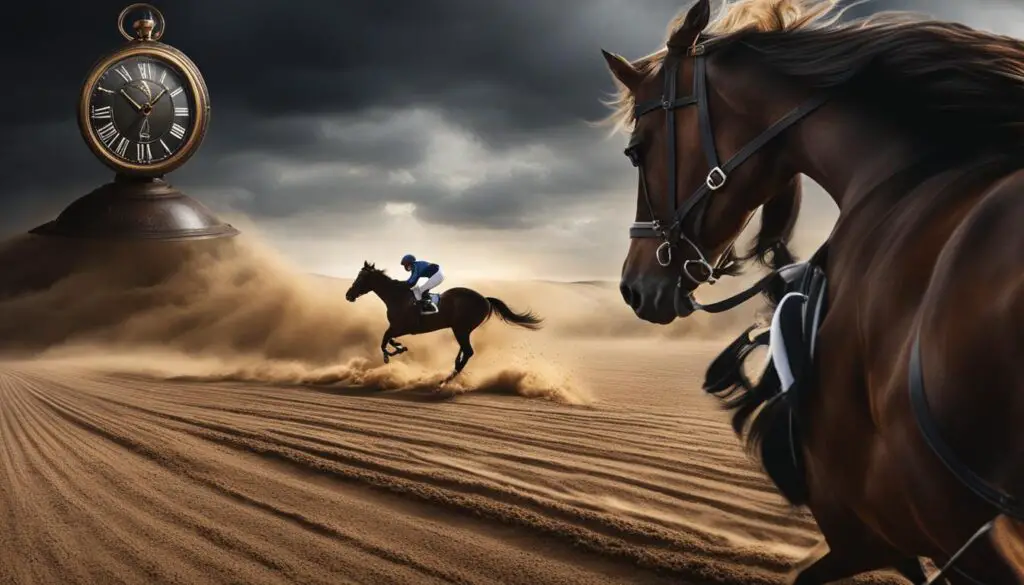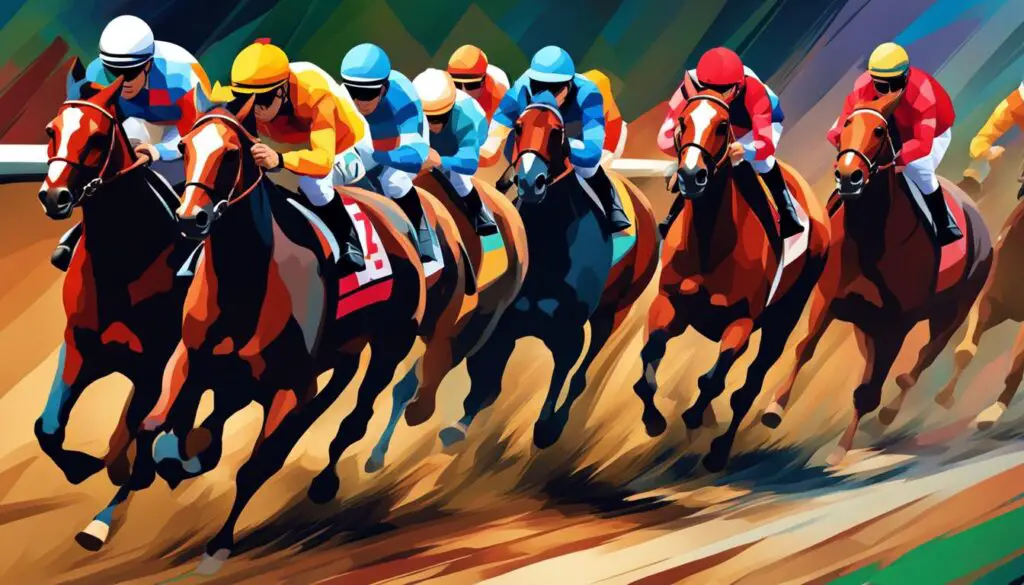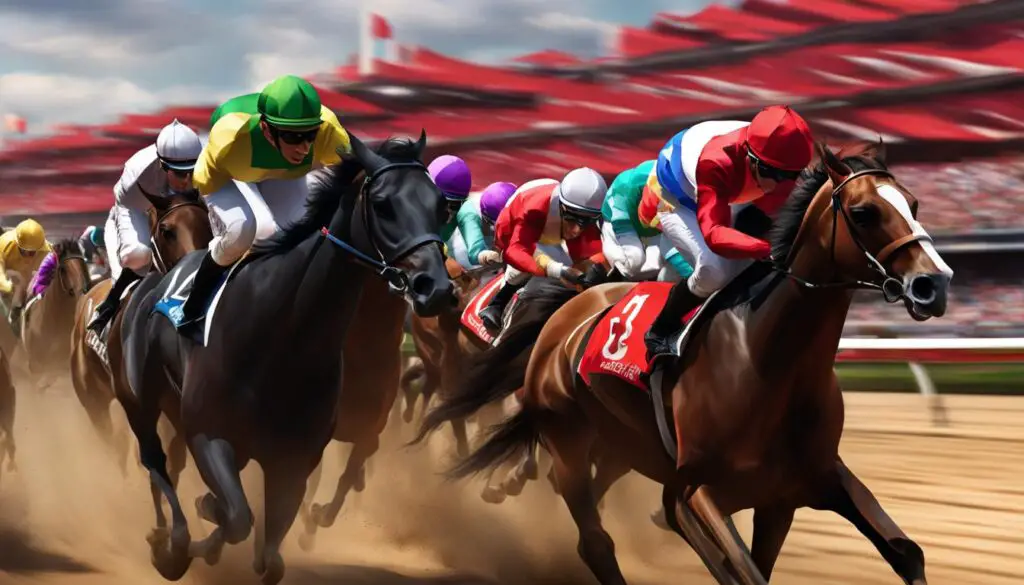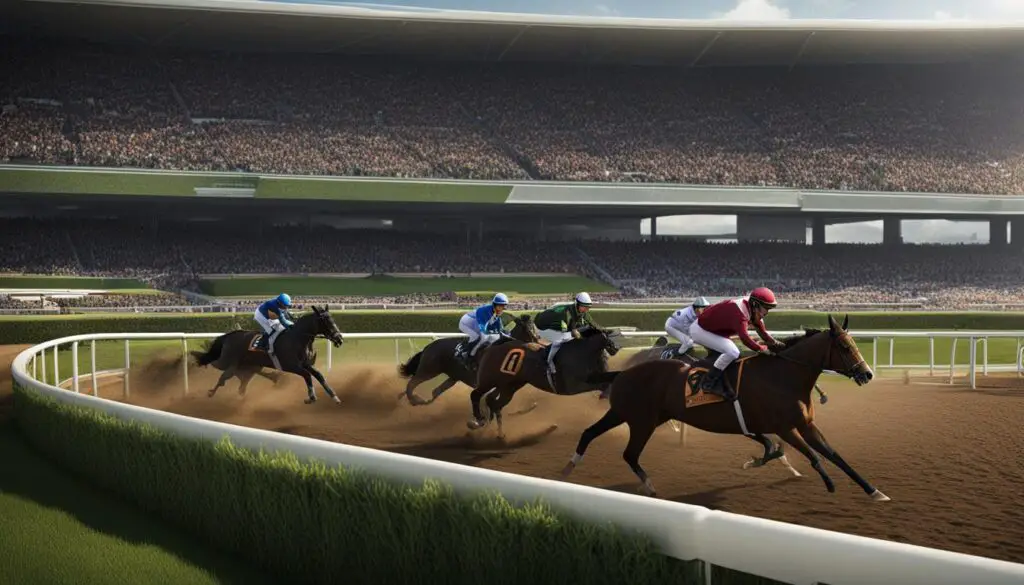Have you ever wondered how long horse races actually last? Whether you’re a racing enthusiast or new to the sport, understanding the duration of horse races can provide valuable insights into this exhilarating sport. From the sprint of a few seconds to the endurance of several minutes, race durations can vary depending on various factors.
On average, horse races can last anywhere from a few seconds to several minutes. The length of a race is typically measured in furlongs, with each furlong equivalent to one eighth of a mile. The average length of a horse race can range from 5 furlongs (5/8 mile) to 1 1/2 miles or more for longer distance races such as the Kentucky Derby.
The duration of a race is influenced by factors such as track conditions, horse speed, and jockey strategy. Additionally, unforeseen circumstances like horse falls or disqualifications can impact race time, resulting in stops or prolongations.
So, whether you’re interested in betting, spectating, or simply gaining a deeper understanding of the sport, knowing how long horse races last is a key piece of knowledge. Join us as we delve into the nuances of horse race durations, exploring different types of races and the factors that influence their duration.
Key Takeaways:
- Horse races can last from a few seconds to several minutes, depending on various factors.
- The average length of a horse race can range from 5 furlongs to 1 1/2 miles or more.
- Factors such as horse speed, track conditions, and jockey strategy affect race duration.
- Unforeseen circumstances like horse falls or disqualifications can impact race time.
- Understanding race durations can enhance your overall enjoyment and insight into the world of horse racing.
Understanding Horse Racing Form and Terminology
Horse racing form is a crucial aspect of the sport that provides valuable insights into a horse’s performance and can help bettors make informed decisions. The form refers to the historical record of a horse’s previous races, including details such as finishing positions, race types, distances, jockey and trainer information, and more. It serves as a comprehensive guide to understanding a horse’s capabilities and formulates strategies for future races.
However, reading horse racing form can be challenging, as it often involves the use of abbreviations and specific terminology unique to the sport. Familiarizing yourself with these terms is essential to fully comprehend the information presented in the form guide. In publications, websites, and mobile apps, you can find detailed form guides that provide easy access to a horse’s complete race history.
“The form guide is a treasure trove of information for bettors, allowing them to delve into a horse’s past performances and assess its potential in an upcoming race.”
Common Horse Racing Terminology
- Furlong: A unit of measurement in horse racing, equivalent to one eighth of a mile.
- Handicap: A race in which horses carry weights assigned by the handicapper to equalize their chances of winning.
- Maiden: A race for horses that have not yet won a race.
- Stakes: Races that offer significant prize money and attract high-quality horses.
- Claiming: Races in which horses are available for purchase before the race.
By understanding horse racing form and becoming familiar with the terminology, bettors can gain a comprehensive understanding of a horse’s capabilities and make more informed betting decisions. It is an essential tool for both novice and experienced bettors in their quest for success on the racetrack.
Factors Influencing Race Duration
In horse racing, several factors can influence the duration of a race. These factors can affect how quickly the horses run and ultimately determine the race time. Understanding these factors can provide valuable insights for bettors and enhance the overall appreciation of the sport.
One of the key factors affecting race duration is the track conditions. The type of surface, such as dirt or turf, and the weather conditions, such as wet or dry, can impact the speed at which horses can run. A firmer surface and favorable weather conditions generally lead to faster race times, while a softer or wetter surface may slow down the horses.
The speed and running style of the horses, as well as the jockey’s strategy, can also have a significant impact on race duration. Horses with faster speeds and more efficient running styles can complete the race in a shorter duration compared to slower horses. Likewise, the jockey’s strategy, including pacing and positioning during the race, can affect the overall race performance and time.
Another factor that plays a role in race duration is the length of the race itself. Shorter races, such as sprints, typically have shorter durations compared to longer distance races. The pace at which horses run in sprint races is generally faster, resulting in quicker race times. On the other hand, longer distance races require horses to maintain a steady pace over a longer period of time, resulting in longer race durations.

Unforeseen Circumstances
In addition to the factors mentioned above, unforeseen circumstances can also impact race duration. These circumstances can include horse falls or disqualifications, which can cause delays or interruptions in the race. When such incidents occur, it is necessary to address the situation and ensure the safety of the horses and jockeys involved. These unforeseen circumstances can have an unpredictable impact on the overall duration of the race.
Summary:
- Track conditions, such as the type of surface and weather conditions, can affect race duration.
- Horses with faster speeds and more efficient running styles tend to complete races in shorter durations.
- The jockey’s strategy, including pacing and positioning, can impact race duration.
- The length of the race itself determines how long it takes for horses to complete the distance.
- Unforeseen circumstances such as horse falls or disqualifications can disrupt race duration.
Types of Horse Racing Events
Horse racing encompasses various types of events, each with its own unique characteristics and rules.
Flat racing, also known as Thoroughbred racing, is the most common type of horse racing and involves horses running on a flat track without obstacles.
Jump racing, also known as National Hunt racing, involves horses navigating obstacles such as hurdles or fences.
Harness racing involves horses pulling a driver in a two-wheeled cart called a sulky.
Endurance racing is a long-distance race where horses compete over extended distances, often covering 50 miles or more.
Flat Racing
In flat racing, horses run on a flat track without obstacles, competing to be the fastest over a specified distance. This type of racing is commonly seen in prestigious events like the Kentucky Derby and the Royal Ascot.
Jump Racing
Jump racing requires horses to navigate and jump over obstacles such as hurdles or fences. It is a test of both speed and jumping ability, with races often taking place on grass or turf tracks.
Harness Racing
In harness racing, horses pull a driver in a two-wheeled cart called a sulky. The driver guides the horse while trying to maintain a specific pace and strategy to outpace their competitors.
Endurance Racing
Endurance racing is a test of stamina and endurance, with horses covering long distances over challenging terrains. These races can last several hours, pushing both horse and rider to their limits.
Each type of horse racing event offers a unique experience for spectators and participants, showcasing the diverse skills and abilities of these magnificent animals.
Average Durations of Different Horse Races
When it comes to the duration of horse races, there are significant variations depending on the type of race. Flat races, which are the most common type of horse racing, have an average duration of around 1 to 2 minutes for sprints of 5 furlongs (5/8 mile) and up to 3 to 4 minutes for longer distance races of 1 1/4 miles or more. Jump races, on the other hand, tend to have longer average durations due to the inclusion of obstacles. These races can last anywhere from 5 to 10 minutes or more, depending on the track and the hurdles or fences involved.
Harness races, which involve horses pulling a driver in a two-wheeled cart called a sulky, typically have shorter average durations of around 2 to 3 minutes. Finally, endurance races, the longest type of horse racing, can last several hours. These races cover extended distances of 50 miles or more, with horses maintaining a steady pace over a longer period of time.
“The average duration of a horse race can vary depending on the type of race, with flat races typically lasting 1 to 2 minutes, jump races lasting 5 to 10 minutes, harness races lasting 2 to 3 minutes, and endurance races lasting several hours.”
These average durations provide an idea of the time commitment required for different horse races. Whether you prefer the quick adrenaline rush of a flat race or the endurance test of an extended distance race, each type of race offers its own unique experience for both participants and spectators.
Examples of Average Durations:
- Flat races: 1-2 minutes for sprints, 3-4 minutes for longer distances
- Jump races: 5-10 minutes or more
- Harness races: 2-3 minutes
- Endurance races: several hours

Race Distance and Duration: Exploring the Impact
When it comes to horse racing, the distance of a race can greatly influence its duration. Shorter races, often referred to as sprint races, can be completed in just a matter of minutes. These races typically cover distances of 5 furlongs to 7 furlongs (5/8 mile to 7/8 mile). With horses running at a faster pace, sprint races provide an exhilarating burst of speed and excitement for spectators.
On the other hand, longer races, known as distance races, require horses to maintain a steady pace over a greater distance. These races can last several minutes or more, depending on the specific race distance. The endurance and stamina of both the horse and jockey are put to the test as they navigate the longer track. Distance races offer a different kind of excitement, with tactics and strategy playing a crucial role in determining the outcome.
Regardless of the race duration, sprint or distance, each presents its own unique challenges and rewards. Sprint races showcase the sheer speed and acceleration of racehorses, while distance races highlight the endurance and staying power required to successfully complete a longer course. Whether you prefer the quick thrill of a sprint or the strategic battle of a distance race, horse racing offers a diverse range of experiences to suit every enthusiast.
Historical Race Durations and Records
It is in the realm of horse racing records that we find the epitome of speed and endurance. These records not only showcase the remarkable abilities of racehorses but also capture the imagination of racing enthusiasts around the world. From the fastest race times to the longest endurance races, horse racing records provide a glimpse into the extraordinary achievements of these magnificent animals.
Track records serve as a testament to the speed and agility of horses on a specific track and distance. Each track has its own set of records, representing the fastest recorded times for various race distances. These records can vary based on factors such as track condition, weather, and the quality of the competition.
“Horse racing records and fastest race times can provide an insight into the potential speed and abilities of racehorses.”
World records in horse racing, on the other hand, transcend individual tracks and distances, showcasing the absolute best performances regardless of location. These records highlight the exceptional talents of racehorses that have achieved extraordinary speeds and accomplished remarkable feats.
One of the most famous horse racing records is held by Secretariat, who set the world record for the fastest time in the Kentucky Derby in 1973. Secretariat completed the race in a breathtaking 1 minute and 59.40 seconds, a record that still stands today. Other legendary racehorses, such as Seabiscuit and Zenyatta, have also left their mark in the record books, captivating audiences with their incredible speed and determination.

Factors Affecting the Race Time
Several factors can influence the race time in horse racing, making each race a unique and dynamic event. These factors include:
- Track Conditions: The firmness or softness of the track surface can affect the speed at which horses can run. A firm and well-maintained track can provide a faster surface for horses to run on, resulting in quicker race times.
- Weather Conditions: The temperature, wind, and other weather factors can impact race times. Horses may run faster in cooler temperatures, while strong headwinds can slow down their pace.
- Quality of Competition: The caliber of competing horses can influence the overall pace of the race. Stronger competition can push horses to run faster, resulting in faster race times.
- Horse Form and Fitness: The physical condition and fitness level of the horse play a crucial role in determining race time. A well-trained and fit horse is likely to perform better and achieve faster race times.
- Jockey Skill and Strategy: The skill and strategy employed by the jockey can significantly impact the performance and race time. A skilled jockey can make critical decisions during the race to optimize speed and positioning.
It’s important to note that while these factors can influence race time, they are also interconnected. For example, track conditions and weather can affect the horse’s performance and jockey strategy. A comprehensive understanding of these factors and their impact on race time can help bettors make more informed decisions and appreciate the intricacies of horse racing.

Record-Breaking Horse Races
Throughout the history of horse racing, there have been legendary racehorses and notable race performances that have captivated audiences and set records. These record-breaking horse races have become a part of racing history and have solidified the legacies of both the horses and jockeys involved.
One such legendary racehorse is Secretariat, who holds the record for the fastest race times in the Kentucky Derby, Preakness Stakes, and Belmont Stakes. Secretariat’s remarkable speed and dominance on the track made him a true icon in the world of horse racing. Another famous racehorse, Seabiscuit, achieved fame with his remarkable come-from-behind victories and memorable performances.
These record-breaking races and performances leave a lasting impression on fans and enthusiasts, showcasing the incredible athleticism and determination of both horse and rider. They serve as a testament to the beauty and excitement of horse racing, and continue to inspire awe and admiration in the hearts of racing fans around the world.
Notable Race Performances
- Secretariat’s record-breaking Triple Crown victory in 1973
- Seabiscuit’s thrilling come-from-behind win against War Admiral in the 1938 Pimlico Special
- Zenyatta’s undefeated season in 2009, culminating in a thrilling come-from-behind victory in the Breeders’ Cup Classic
- Man o’ War’s dominant win in the 1920 Belmont Stakes, setting a new world record for a mile and three-eighths race
These races and performances have left an indelible mark on the world of horse racing, forever etching their names into the annals of the sport’s history.
Legendary Racehorses
- Secretariat: A Triple Crown winner and record-breaker known for his incredible speed and dominance on the track
- Seabiscuit: An underdog who captured the hearts of the nation with his tenacity and thrilling come-from-behind victories
- Zenyatta: A beloved mare who achieved an undefeated season and captured the hearts of fans with her electrifying late runs
- Man o’ War: An iconic racehorse of the early 20th century, known for his exceptional speed and powerful stride
These legendary racehorses have become household names, forever embedded in the rich tapestry of horse racing history. Their accomplishments and records continue to inspire future generations of racehorses and leave an enduring legacy in the sport.
Betting and Anticipation in Horse Racing
Horse racing is not just a thrilling sport to watch, but it also offers an exciting opportunity for betting enthusiasts. The anticipation leading up to a race is palpable, as spectators eagerly await the moment the gates open and the horses thunder down the track. Betting on horse races adds an extra layer of excitement, as it allows spectators to engage with the race on a more personal level and potentially profit from their predictions.
When it comes to betting on horse races, understanding the odds and favorites is crucial. The odds represent the probability of a horse winning a race, and they are determined based on factors such as the horse’s past performance, jockey and trainer reputation, and market perception. Favorites are the horses with the lowest odds, indicating that they are considered the most likely to win. However, it’s important to remember that favorites don’t always come out on top, and there are often lucrative opportunities to be found in betting on underdogs.
To increase your chances of success, it’s essential to develop effective betting strategies. Some bettors prefer to focus on analyzing the form and statistics of horses, while others rely on insider tips or follow the advice of professional handicappers. Many bettors use a combination of factors, such as studying the horse’s past performances, evaluating the jockey’s skill and strategy, and considering track and weather conditions. By conducting thorough research and staying informed about the latest developments in the racing world, you can make more informed betting decisions.
Key Points:
- Horse racing offers an exciting opportunity for betting enthusiasts.
- The anticipation leading up to a race adds to the thrill of the sport.
- Understanding the odds and favorites is crucial for successful betting.
- Developing effective betting strategies can increase your chances of success.
“Betting on horse races is like navigating a thrilling maze of potential outcomes, where strategy and intuition go hand in hand.” – Anonymous
The Thrill of Horse Racing
Horse racing is more than just a sport; it’s an electrifying experience that captures the hearts of spectators. The excitement of horse racing permeates the atmosphere at racecourses, creating an unforgettable ambiance that draws people in. The roar of the crowd as the horses thunder down the track, the anticipation building with every stride, and the collective joy or disappointment when the race concludes – all of these elements contribute to the thrill of horse racing.
Attending a horse race offers a unique social experience, bringing people together in their shared passion for the sport. Whether you’re a seasoned bettor or a casual spectator, there’s a sense of camaraderie among racegoers as they cheer on their favorite horses and engage in friendly banter. Horse racing events also provide opportunities to relax, socialize, and enjoy delicious food and drinks. It’s a chance to escape from everyday life and immerse yourself in a vibrant community of horse racing enthusiasts.
“The atmosphere at horse races is unlike anything else. The energy is palpable, the tension is high, and the excitement is contagious. It’s a thrilling experience that keeps me coming back for more.”
As a spectator, you’re not just a passive observer – you become an active participant in the excitement. Placing bets adds an extra layer of anticipation and joy, as you watch the race unfold and root for your chosen horse. The race itself is an exhilarating spectacle, with horses reaching incredible speeds and jockeys showcasing their skill and agility. From photo finishes to underdog victories, each race is filled with captivating moments that leave lasting impressions on those lucky enough to witness them.
Experience the Thrill of Horse Racing:
- Immerse yourself in the atmosphere at a local racetrack
- Place a bet and root for your favorite horse
- Take part in the social aspect by engaging with fellow racegoers
- Enjoy the thrill of the race and savor the memorable moments
Whether you’re a lifelong fan or a curious newcomer, the thrill of horse racing promises an unforgettable experience. Soak in the excitement, embrace the atmosphere, and let the power and grace of these magnificent animals captivate your senses. Horse racing is a sport like no other, where the thrill of the race is matched only by the joy of being a part of something truly extraordinary.
Conclusion: Racing Insights and Enjoyment
Understanding race durations and gaining insights into the world of horse racing can greatly enhance your enjoyment of this exhilarating sport. By familiarizing yourself with the nuances of horse racing, such as the average duration of different race types and the factors that can influence race times, you can develop a deeper appreciation for the athleticism and strategy involved in each race.
Embracing the horse racing experience goes beyond just placing bets or watching the races unfold. It’s about immersing yourself in the rich history and traditions of the sport, connecting with fellow enthusiasts, and enjoying the unique atmosphere that envelopes the racetrack. Whether you’re a casual spectator or a seasoned bettor, the thrill and excitement of horse racing can create lasting memories and a sense of camaraderie among like-minded individuals.
So, dive into the world of horse racing, explore the intricacies of race durations, and revel in the sheer enjoyment that this timeless sport offers. Whether you’re captivated by the thundering hooves, the suspenseful moments leading up to the finish line, or the strategic maneuvers of the jockeys, horse racing has a way of captivating and inspiring us. So don your finest attire, place your bets, and experience the thrill of horse racing for yourself – it’s an experience you won’t soon forget.
FAQ
How long do horse races last?
Horse races can vary in duration, but on average, they can last anywhere from a few seconds to several minutes.
What factors can influence the duration of a horse race?
The duration of a horse race can be affected by factors such as track conditions, horse speed, jockey strategy, and the length of the race itself.
What are the different types of horse racing events?
Horse racing events can include flat racing, jump racing, harness racing, and endurance racing.
How long is the average duration of a horse race?
The average duration of a horse race can vary depending on the type of race, ranging from around 1-2 minutes for sprints to several minutes for longer distance races.
Does the race distance affect the duration of a horse race?
Yes, the length of the race can impact the duration, with shorter races typically lasting shorter durations compared to longer races.
What are some notable horse racing records?
Horse racing records include the fastest race times, longest endurance races, and extraordinary performances by legendary racehorses.
What factors can impact the race time in horse racing?
Factors such as track conditions, weather conditions, the quality of the competition, horse form and fitness, and jockey skill and strategy can all influence the race time.
Are there any famous and record-breaking horse races?
Yes, there have been several famous races that have achieved fame through exceptional performances and record-breaking race times.
How does betting work in horse racing?
Betting on horse races involves analyzing the form and odds to make informed decisions and potentially profit from wagers.
What is the thrill of horse racing?
Horse racing offers a unique atmosphere and social experience, filled with anticipation, excitement, and the thrill of watching the races unfold.
How can I understand and enjoy horse racing more?
By familiarizing yourself with horse racing form, terminology, and the specific characteristics of different race types, you can gain valuable insights and enhance your enjoyment of the sport.
